Stone Crab
Females can lay up to a million eggs in one sitting
Advertisement
Stone Crab Scientific Classification
Stone Crab Facts
- Prey
- Mollusk, oysters
- Fun Fact
- Females can lay up to a million eggs in one sitting
- Estimated Population Size
- Unknown
- Most Distinctive Feature
- Two uneven but oversized claws
- Other Name(s)
- Florida stone crab
- Gestation Period
- Up to two weeks
- Habitat
- Waters off the Florida coast
- Predators
- Octopi, sea turtles
- Diet
- Carnivore
- Number Of Species
- 2
View all of the Stone Crab images!
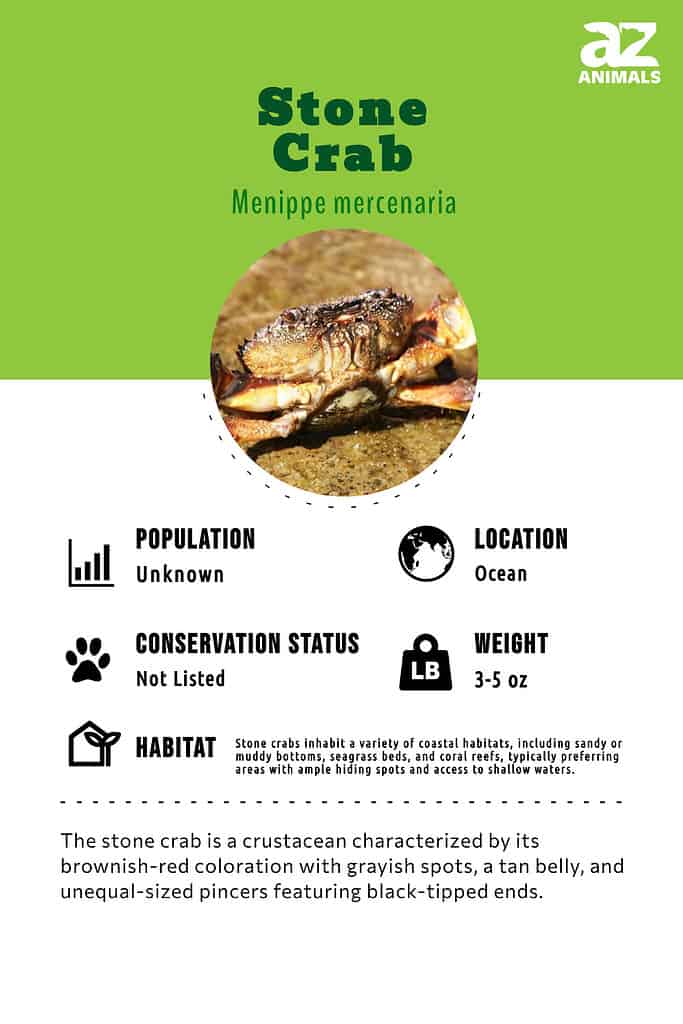
Over 90 percent of marketed stone crabs come out of Florida.
In fact, the animals are often referred to as Florida stone crabs. But you can find this crab in offshore and coastal waters from Belize to North Carolina. They also populate the waters of Mexico‘s gulf, the Greater Antilles, the Bahamas, and the Yucatan Peninsula. The stone crab’s claws are an expensive global delicacy.
5 Incredible Stone Crab Facts!
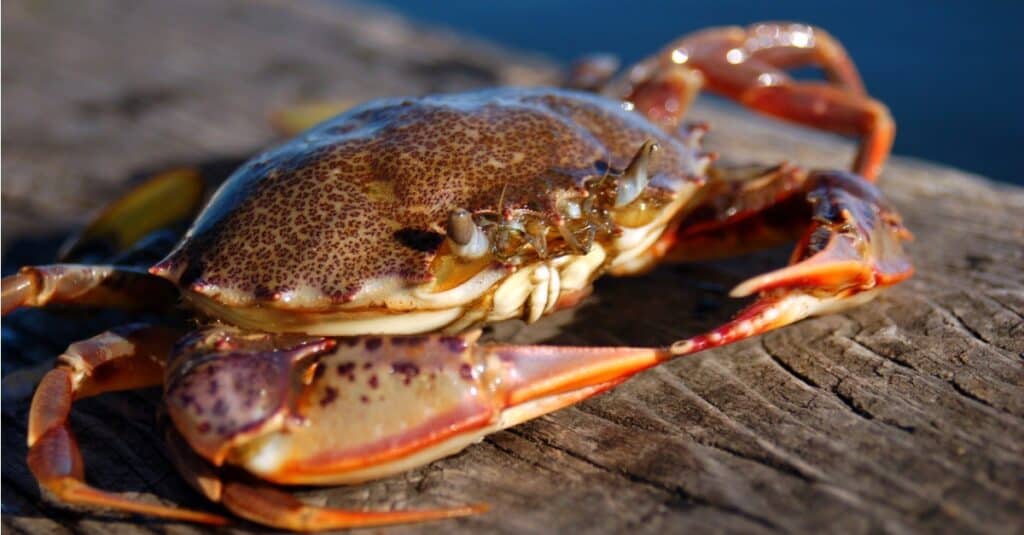
Soft-shell crabs are the result of stone crabs undergoing molting and discarding their rigid exteriors. This transformation generally occurs within a span of two to three hours.
©iStock.com/Kirkikis
Here are five cool things you likely didn’t know about the stone crab.
- Soft-shell crabs are stone crabs – Soft-shell crabs are what we get after stone crabs go through their molting stage and shed their hard shells. The process typically takes two to three hours.
- Stone crabs are generally right-handed – The right hand is often bigger than the left and stronger. The animal has powerful claws either way. The limb is capable of crushing 19,000 pounds per square inch.
- Females live a little longer – Female crabs will hang out for at least eight years. The male stone crab tends to live around seven.
- The stone crab manages a HUGE family – Females produce sponges, four to six egg sacks. In a single production, they can lay around 1,000,000 eggs.
- Only claws get harvested – Claws have a short shelf life. When shopping, you have to assess them through touch and smell. If there’s even a slight odor of ammonia or the limbs are slimy and/or sticky, you don’t want to buy them.
Classification and Scientific Name
While the stone crab consists of two species, the Menippe mercenaria and the M. adina, the M. adina (or gulf stone crab) is often seen as a subspecies of the M. mercenaria.
The two species do create hybrids through interbreeding while both are usually considered one species for the purpose of commercial fishing.
The stone crab is a member of the Animalia family. This is a broad term for any eukaryotic, multicellular organism that consumes organic material, is able to move, reproduces through sexual contact, and breathes oxygen. The category includes humans.
Evolution and Origins
Florida is the primary source for an impressive 98% of stone crabs. At the renowned Lobster Place in Chelsea Market, which happens to be one of New York City’s largest seafood retailers and wholesalers, they have an exclusive partnership with Rich Crawford.
Rich Crawford personally operates and owns traps in the bountiful waters off Manasota Key along the Gulf Coast of Florida, ensuring a reliable and top-quality supply of stone crabs.
Throughout the course of evolution, five distinct branches within the decapod family have independently undergone adaptations that have resulted in the formation of crabs.
Under specific environmental conditions, certain traits have proven advantageous, leading multiple species to gradually develop crab-like characteristics over time.
Species
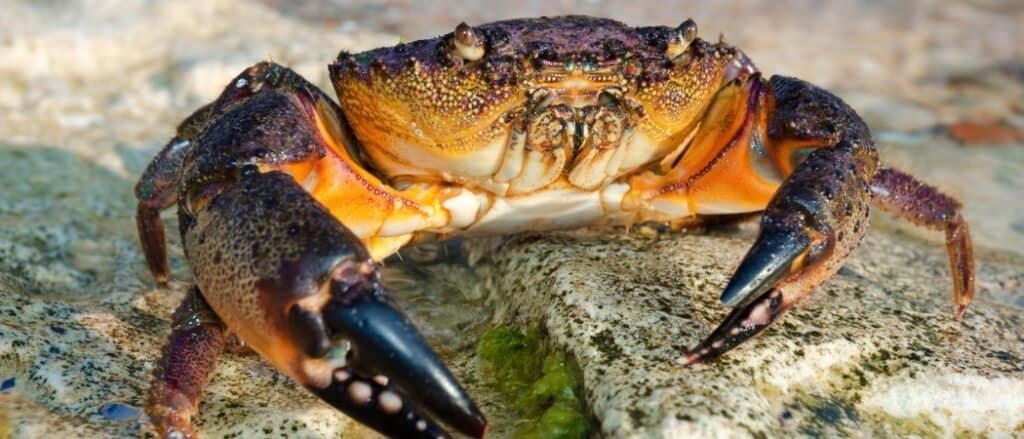
Within the Southeastern United States, two distinct species of stone crabs can be found.
©iStock.com/connect11
Inside the Southeastern United States, there are two unique species of stone crabs. The Menippe mercenaria is found in Florida’s peninsula. The Menippe adina swims in the western and northern Gulf of Mexico waters.
The two species are unique through their genetics and coloration. There are also differentiating traits regarding reproduction, temperature tolerance, salinity, and ecology.
Here are several characteristics that separate the species.
| M. adina | M. mercenaria | |
|---|---|---|
| Claw and Body Color | Medium or light gray to tan | A maroon to deep chocolate color |
| Unique Markings | Spotted, usually black and small but uniform | Typically solid with occasional light brown mottling |
| Leg Markings and Color | Distinct white bands on dark brown | Solid and deep chocolate to maroon |
| Habitat | Rocky outcrops, limestone sand, seagrass beds | Rocky outcrops, limestone sand, seagrass beds |
Appearance
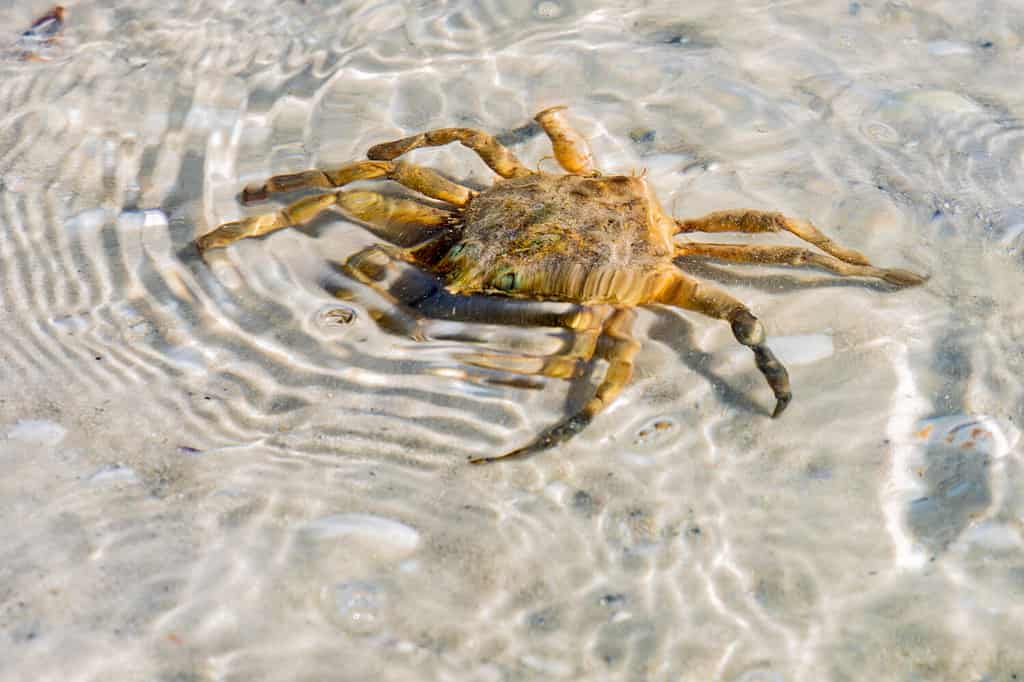
This particular animal displays a brownish-red hue with grayish spots, accompanied by a tan-colored belly. Notably, its prominent pincers feature black-tipped ends and are of unequal sizes.
©Ami Parikh/Shutterstock.com
The animal is brownish-red with grayish spots and a tan belly. Their large pincers have black tips and the sizes are unequal.
The stone crab’s shell, or carapace, is about four inches wide and between three to 3.5 inches long. The carapace is smooth, oval, and convex.
The trunk’s composed of 14 parts. The crabs have five pairs of walking legs that have distal hairs and yellow and reddish bands.
The baby crab has a white spot on the middle segment of the animal’s endopod. The baby crab will develop a dark purple-blue color as they grow into juveniles.
Females have larger carapaces while males have larger claws.
Their dark color lets them blend into mud substrates, allowing them to better conceal themselves against predators.
Distribution, Population, and Habitat
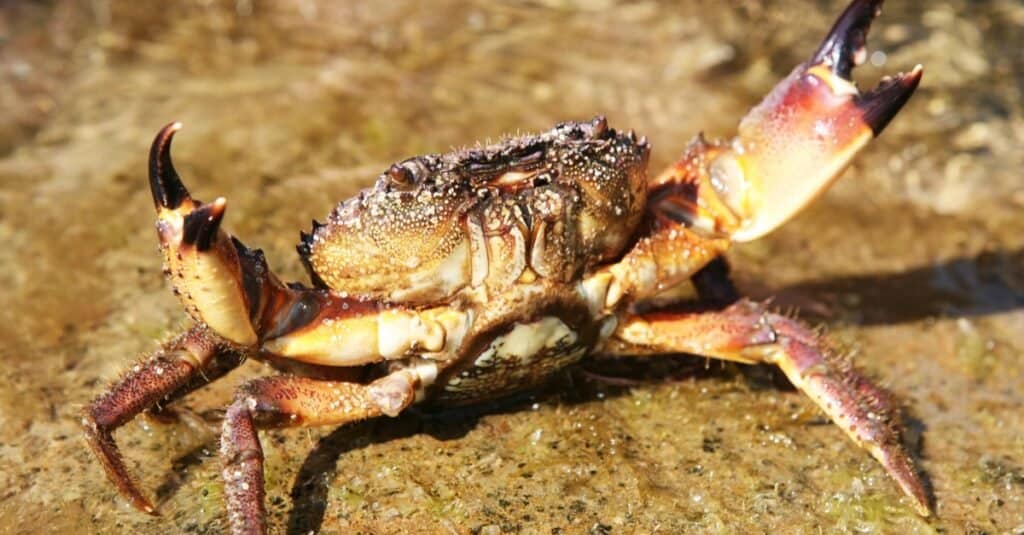
©alexsmaga/Shutterstock.com
Here are facts about the lifespan of these crabs.
Distribution
In the United States, the largest distribution of these crabs is along the Gulf Coast.
Population
This crab population is quite healthy and far from endangered. A large influence here is there are strict regulations governing the season when you can harvest them and — most importantly — how the creatures are harvested. The crab is one of the few animals that aren’t killed for food. If the fishermen are responsible, the stone crab is safely returned to the wild after its declawing.
Over time, as the creature molts, it will generate new claws. But it’s a slow process that can take up to three years. Older crabs never fully regenerate their claws. The regrowth is greatly influenced by how responsibly fishermen follow regulations concerning claw removal.
Habitat
These crabs live at the bottom of bays, rock jetties, and oyster reefs. You’ll also spot the crabs in limestone sand and seagrass beds. They like to burrow and find refuge from their predatory adversaries. The baby and juvenile don’t spend a lot of time digging. Instead, they hide in seagrass or amid rocks.
Predators and Prey
The list of predators of the crab includes octopi (the crab’s main threat), large fish, sea turtles, and, of course, humans.
There are actually few predators the crab worries about. The size and power of its claws, as well their hardened exoskeleton, keep predatory behavior to a minimum. The stone crab’s known to use its claws to gash and pinch a predator’s gastrointestinal lining.
Pre-juvenile and larvae stages feed on small zooplankton. Growing, they continue with opportunistic carnivore behavior but move on to larger food sources. Adult stone crabs regularly eat hard-shelled clams, small mollusks, acorn barnacles, conch, scallops, and various crustaceans.
Reproduction and Lifespan
After molting, the crabs mate. After fertilization and ovarian development are complete, the female deposits eggs in a sponge or external mass beneath the female’s abdomen. The number of eggs can be up to one million.
At this time, the female is ovigerous (egg-bearing). It is illegal to capture females in this state. (Fishermen can recognize the condition.) Eggs hatch in less than 14 days. The larval stage takes about four weeks. Then there’s the juvenile metamorphosis stage.
The adult crab will live up to seven years, and the female eight.
Fishing and Cooking
The stone crab claw is a seafood favorite. By law, you are only allowed to declaw if claws are at least 2¾ inches. Only a legal size claw can be removed before returning the animal to the water.
Crabmeat has a variety of recipes. The process is to sauté — quickly cook — the meat to not lose flavor and to sustain its flaky texture.
View all 293 animals that start with SStone Crab FAQs (Frequently Asked Questions)
What is a stone crab?
The stone crab is a fish that lives in gulfs, coasts, and peninsulas in several points of the Western world. Their claws are a delicacy around the world.
When is stone crab season?
In Florida — where we get over 90 percent of our crab meat — harvest season starts in October and ends in mid-May. Seasonal regulations were recently shortened to protect egg-bearing females that were getting trapped in increasing numbers during their fertile periods.
Where are stone crabs found?
A huge population resides in Florida. You also find the crab in the waters of Belize, North Carolina, the Gulf of Mexico, the Greater Antilles, the Bahamas, and the Yucatan Peninsula.
Are stone crabs good to eat?
The meat of the stone crab is flaky, sweet, and succulent. You crack the shell and eat the meat like finger food. Usually cooked in the same fashion as shrimp, it’s said the taste is a mix of shrimp and lobster.
Can stone crabs hurt you?
That depends on what you’re talking about. If eating the animal, it’s possible to have an allergic reaction. But overall, there is no evidence of fresh crab being harmful to human physiology. Now, if you let yourself get caught in a stone crab’s claw, expect a badly bruised or broken finger.
What is the lifespan of a stone crab?
The male stone crab lifespan is about seven years while the female’s life cycle adds an extra year.
Why is it called a stone crab?
The name derives from the density of the crab’s hard exterior.
Why is stone crab so expensive?
The claws are one of the most costly seafood. A pound of stone crab claws runs about twice the cost of Alaskan snow crab legs. One of the reasons is the labor-intensive procedures for catching them, including using the safest methods to remove the claws and returning the crab back to the water.
What's the difference between stone crabs and Jonah crabs?
Stone crabs have differently shaped claws, while Jonah crab claws are even. Jonah crabs also have shorter lifespans compared to stone crabs.
Thank you for reading! Have some feedback for us? Contact the AZ Animals editorial team.
Sources
- Food Republic, Available here: https://www.foodrepublic.com/2017/01/19/fun-facts-stone-crabs/
- Wikipedia, Available here: https://en.wikipedia.org/wiki/Florida_stone_crab
- Stone Crab Florida, Available here: http://www.stonecrabflorida.com/stone-crab-facts.html
- Florida Fish and Wildlife Conservation Commission, Available here: https://myfwc.com/research/saltwater/crustaceans/stone-crabs/about/
- Monterey Bay Aquarium Seafood Watch, Available here: http://www.seachoice.org/wp-content/uploads/2011/12/MBA_SeafoodWatch_StoneCrabReport1.pdf
- Animal Diversity Web, Available here: https://animaldiversity.org/accounts/Menippe_mercenaria/#76064c014d81c3748daeae0d5632afee
- Florida Fish and Wildlife Conservation Commission, Available here: https://myfwc.com/research/saltwater/crustaceans/stone-crabs/proposed-evolutionary-history/
- Texas Parks & Wildlife, Available here: https://tpwd.texas.gov/huntwild/wild/species/stonecrab/
- Florida Fish and Wildlife Conservation Commission, Available here: https://myfwc.com/research/saltwater/crustaceans/stone-crabs/

















